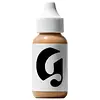What's inside
What's inside
 Key Ingredients
Key Ingredients

 Benefits
Benefits

 Concerns
Concerns

 Ingredients Side-by-side
Ingredients Side-by-side

Water
Skin ConditioningCyclopentasiloxane
EmollientCyclohexasiloxane
EmollientDimer Dilinoleyl Dimer Dilinoleate
EmollientPEG-10 Dimethicone
Skin ConditioningGlycerin
HumectantPolymethylsilsesquioxane
Alcohol
AntimicrobialDimethicone
EmollientMica
Cosmetic ColorantCaprylyl Glycol
EmollientSodium Chloride
MaskingDisteardimonium Hectorite
StabilisingChlorphenesin
AntimicrobialPropylene Carbonate
SolventBoron Nitride
AbsorbentTriethoxycaprylylsilane
Ricinus Communis Seed Oil
MaskingZea Mays Oil
EmulsifyingDiamond Powder
AbrasiveQuercus Suber Bark Extract
Skin ConditioningCI 77891
Cosmetic ColorantCI 77491
Cosmetic ColorantCI 77492
Cosmetic ColorantCI 77499
Cosmetic ColorantWater, Cyclopentasiloxane, Cyclohexasiloxane, Dimer Dilinoleyl Dimer Dilinoleate, PEG-10 Dimethicone, Glycerin, Polymethylsilsesquioxane, Alcohol, Dimethicone, Mica, Caprylyl Glycol, Sodium Chloride, Disteardimonium Hectorite, Chlorphenesin, Propylene Carbonate, Boron Nitride, Triethoxycaprylylsilane, Ricinus Communis Seed Oil, Zea Mays Oil, Diamond Powder, Quercus Suber Bark Extract, CI 77891, CI 77491, CI 77492, CI 77499
Water
Skin ConditioningCyclopentasiloxane
EmollientCyclohexasiloxane
EmollientC13-15 Alkane
SolventDimethicone
EmollientEthylhexyl Methoxycinnamate
UV AbsorberLauryl PEG-10 Tris(Trimethylsiloxy)Silylethyl Dimethicone
EmulsifyingMagnesium Sulfate
Polyglyceryl-4 Isostearate
EmulsifyingCetyl PEG/PPG-10/1 Dimethicone
EmulsifyingHexyl Laurate
EmollientMica
Cosmetic ColorantButylene Glycol
HumectantVaccinium Vitis-Idaea Seed Oil
AntioxidantCetearyl Dimethicone Crosspolymer
Phenoxyethanol
PreservativeTitanium Dioxide
Cosmetic ColorantDimethicone/Divinyldimethicone/Silsesquioxane Crosspolymer
HumectantDisteardimonium Hectorite
StabilisingSilica
AbrasiveAluminum Hydroxide
EmollientPropanediol
SolventPropylene Carbonate
SolventPEG-8
HumectantEthylhexylglycerin
Skin ConditioningHydrogen Dimethicone
Tocopherol
AntioxidantSodium Lauroyl Glutamate
Hydrated Silica
AbrasiveTriethoxycaprylylsilane
Lysine
Skin ConditioningMagnesium Chloride
Ascorbyl Palmitate
AntioxidantAscorbic Acid
AntioxidantCitric Acid
BufferingHelianthus Annuus Seed Oil
EmollientRosmarinus Officinalis Leaf Extract
AntimicrobialParfum
MaskingIron Oxides
CI 77891
Cosmetic ColorantWater, Cyclopentasiloxane, Cyclohexasiloxane, C13-15 Alkane, Dimethicone, Ethylhexyl Methoxycinnamate, Lauryl PEG-10 Tris(Trimethylsiloxy)Silylethyl Dimethicone, Magnesium Sulfate, Polyglyceryl-4 Isostearate, Cetyl PEG/PPG-10/1 Dimethicone, Hexyl Laurate, Mica, Butylene Glycol, Vaccinium Vitis-Idaea Seed Oil, Cetearyl Dimethicone Crosspolymer, Phenoxyethanol, Titanium Dioxide, Dimethicone/Divinyldimethicone/Silsesquioxane Crosspolymer, Disteardimonium Hectorite, Silica, Aluminum Hydroxide, Propanediol, Propylene Carbonate, PEG-8, Ethylhexylglycerin, Hydrogen Dimethicone, Tocopherol, Sodium Lauroyl Glutamate, Hydrated Silica, Triethoxycaprylylsilane, Lysine, Magnesium Chloride, Ascorbyl Palmitate, Ascorbic Acid, Citric Acid, Helianthus Annuus Seed Oil, Rosmarinus Officinalis Leaf Extract, Parfum, Iron Oxides, CI 77891
 Reviews
Reviews

Ingredients Explained
These ingredients are found in both products.
Ingredients higher up in an ingredient list are typically present in a larger amount.
Ci 77891 is a white pigment from Titanium dioxide. It is naturally found in minerals such as rutile and ilmenite.
It's main function is to add a white color to cosmetics. It can also be mixed with other colors to create different shades.
Ci 77891 is commonly found in sunscreens due to its ability to block UV rays.
Learn more about CI 77891Cyclohexasiloxane is a type of silicone more commonly known as D6. It is an emollient and solvent.
Cyclohexasiloxane is used to evenly distribute ingredients throughout the product. When applied to the skin, Cyclohexasiloxane evaporates and leaves behind a silky feel.
As an emollient, it can help the skin feel soft and hydrated. It is also used to reduce frizz in hair products.
Learn more about CyclohexasiloxaneCyclopentasiloxane, or D5, is a silicone used to improve texture of products and trap moisture.
D5 is considered lightweight and volatile. Volatile means it evaporates quickly after application. Once evaporated, D5 leaves a thin barrier that helps keep skin hydrated.
It is also an emollient. Emollients help soften the skin and prevent water loss. Silicones create a silky texture in products. D5 helps other ingredients become more spreadable.
Studies show D5 is safe to use in skincare products. We recommend speaking with a skincare professional if you have concerns.
Learn more about CyclopentasiloxaneDimethicone is a type of synthetic silicone created from natural materials such as quartz.
What it does:
Dimethicone comes in different viscosities:
Depending on the viscosity, dimethicone has different properties.
Ingredients lists don't always show which type is used, so we recommend reaching out to the brand if you have questions about the viscosity.
This ingredient is unlikely to cause irritation because it does not get absorbed into skin. However, people with silicone allergies should be careful about using this ingredient.
Note: Dimethicone may contribute to pilling. This is because it is not oil or water soluble, so pilling may occur when layered with products. When mixed with heavy oils in a formula, the outcome is also quite greasy.
Learn more about DimethiconeDisteardimonium Hectorite comes from the clay mineral named hectorite. It is used to add thickness to a product.
It can also help stabilize a product by helping to disperse other ingredients.
Hectorite is a rare, white clay mineral.
Learn more about Disteardimonium HectoriteMica is a naturally occurring mineral used to add shimmer and color in cosmetics. It can also help improve the texture of a product or give it an opaque, white/silver color.
Serecite is the name for very fine but ragged grains of mica.
This ingredient is often coated with metal oxides like titanium dioxide. Trace amounts of heavy metals may be found in mica, but these metals are not harmful in our personal products.
Mica has been used since prehistoric times throughout the world. Ancient Egyptian, Indian, Greek, Roman, Aztec, and Chinese civilizations have used mica.
Learn more about MicaThis ingredient is a solvent. It helps dissolve active ingredients and alter the texture of products.
Propylene Carbonate is commonly used in makeup and with clay, such as montmorillonite or bentonite.
Studies show this ingredient to be safe for cosmetics. When it is undiluted, it can cause skin irritation. (It is always diluted in skincare and makeup). This ingredient is water-soluble.
Propylene Carbonate is created from propylene glycol and carbonic acid.
Learn more about Propylene CarbonateTriethoxycaprylylsilane is a silicone used to bind and stabilize ingredients.
As an emulsifier, it helps prevent ingredients from separating. This can help elongate the shelf life of products.
Triethoxycaprylylsilane is often used to coat mineral sunscreens ingredients to help give a better feel. It also helps reduce oxidative stress in sunscreens.
Learn more about TriethoxycaprylylsilaneWater. It's the most common cosmetic ingredient of all. You'll usually see it at the top of ingredient lists, meaning that it makes up the largest part of the product.
So why is it so popular? Water most often acts as a solvent - this means that it helps dissolve other ingredients into the formulation.
You'll also recognize water as that liquid we all need to stay alive. If you see this, drink a glass of water. Stay hydrated!
Learn more about Water